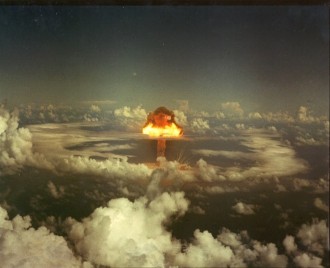What does preparedness mean to you, to your community?
What if the bad guys are somehow able to defeat us and set off a nuclear weapon in downtown LA? Not a dirty bomb, but an actual 10 kiloton nuclear device that results in the stereotypical mushroom cloud over the city.
How should first responders plan for this attack? What are the key actions that should be taken in the first hour, the second hour and beyond? How can we educate our public on what to do in the event of this attack?
This briefing was conducted at the Radiological or Nuclear Incident & Clinical Application Seminar. It is presented by Brooke Buddemeier from the Lawrence Livermore National Laboratories and Global Security. Buddemeier works with DHS on preparation of cities for a nuclear detonation. He is a Certified Health Physicist and radiation safety specialist.
I think you will agree this is an eye opening presentation. I encourage you to watch it from beginning to end and absorb some critical information we don’t often see in the public domain.
Some key points:
Technical:
- A 10 KT detonation gives off the light of 1,000 midday suns up to a mile away for about 15 seconds
- A 10 KT detonation is the equivalent of 5000 Oklahoma City attack truck bombs
- Creates a 600 foot crater
- 3 miles out of from the epicenter, glass will break in buildings – 800,000 people in LA affected within this 3 mile circle
- But, it’s not all bad news – if you can get to shelter you could survive the fallout and there is particle decay as time goes by.
Planning:
- There is apathy in planning – most feel that if a nuclear weapon goes off response doesn’t matter, we’re all casualties, it’s every man for himself. Or it is overwhelming to think about first response to such an event, therefore a lack of planning.
- There are no regional response plans for a nuclear detonation
- There is a misunderstanding about local and federal response and responsibilities
- There is a lack of understanding about the technical aspects of a detonation and the right way to respond
- The first hours are critical and doing the right thing could mean saving hundreds of thousands of lives – or, doing the wrong thing could lead to the death of hundreds of thousands
It is hard to wrap our minds around this type of an attack, but we must. The threat exists – al Qaeda has expressed interest in obtaining nuclear material and building a device; Hezbollah’s sponsor Iran is a nuclear State; radical Islamist terrorist groups in Pakistan could get access through an attack on a facility, planting a mole, or a from a sympathetic scientist or engineer.
We must continue planning as first responders. How do we communicate when the radios, cellphones and computers go down as a result of an electromagnetic event? Do we rush out to help (first instinct) or shelter, survive, then help? Where are our shelters and is the public aware? Do we practice for this type of event and if so, is it realistic?
We have to better educate our citizens. An educated populace is less fearful and their will to survive a detonation will be much higher armed with some knowledge than just operating from a position of fear. We can’t be afraid to have this conversation with our public, they deserve to know and prepare. They shouldn’t over rely on the government during times of crisis, as we’ve seen time and time again in the past.
It strikes me that the generations before us were much more prepared – they knew the location of fallout shelters, for starters. Remember when the bank, the schools, etc in your hometowns had those black and yellow shelter signs? Our parents and grandparents had canned food and water as rations, a radio with batteries, a rallying point and safe area in their homes. There were civil preparedness drills and videos on TV about what to do in the event of a nuclear detonation or related emergency. It was a part of every day life that a nuclear attack was possible – not inevitable, but possible. This is our reality today, as well, although the average person probably gives it no thought at all.
Hope you find this video helpful in your planning efforts at work, in the community and in your home.

